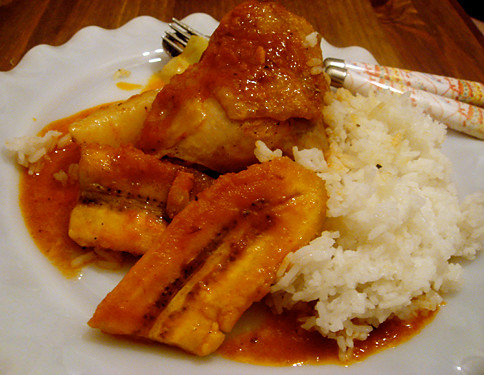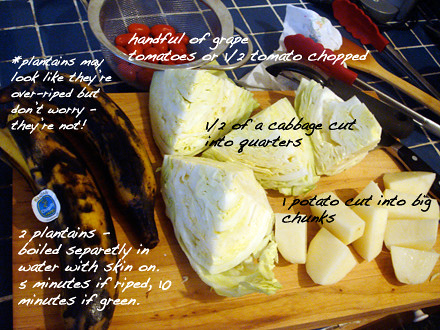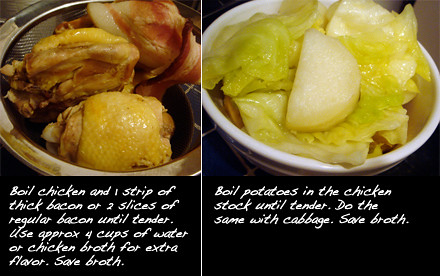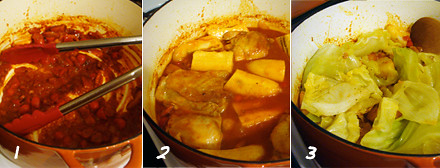Last Night's Dinner #54: Pochero
Filipino week has been extended because there are a few more recipes I'd like to test out and share.
Last night's dish was a first for me. I don't remember ever eating it, let alone cooking it. I'm also starting to realize that most Filipino dishes are orange in color and have a tendency to all look alike, even though each one has a very distinct flavor.
The use of plantain and anatto seed powder really sets this dish apart. I love how the sweetness of the plantains cuts right through the tomato base giving it a really round and robust flavor. I also love the potatoes and cabbage, making it unnecessary to whip up a side dish. Like most Filipino dishes, this one throws in a whole bunch ingredients so when you get bored with the chicken, you can dive right into the cabbage, or the plantain or the potato. However, the best way to eat this dish is to take a little bit of everything with every bite.
After cooking Filipino food for over a week now, I can finally understand why my sister has a hard time translating the recipes into precise measurements. It's a very forgiving cuisine, that really allows the cook to sense and taste their way to perfection. Of course I'll provide detailed instructions, but the best way is to really just provide you with a list of ingredients, some basic guidelines and then allow you to explore your taste buds. Which to me, is the true joy of cooking!
You'll need:
5 chicken thighs (preferably with skin/bone on)
1/2 teaspoon anatto powder
1 tbs of patis (fish sauce), more or less according to taste
1/2 tomato or a handful of grape tomatoes cut into chunks
2 tbs of tomato paste
4 cups of low sodium chicken broth
1/2 head of cabbage, cut into quarters
1/2 onion, finely chopped
2 cloves of garlic, finely chopped
2 riped plantains, boiled with skin on then skinned and cut into 3" pieces then cut lengthwise
1 potato, peeled and cut into big chunks
freshly ground black pepper to taste
kosher salt to taste
Basic Guidelines:
Boil chicken, bacon and vegetables separately in chicken stock until tender. Set aside. Brown chicken in oil and set aside. Sauté onion, garlic, tomatoes, anatto powder, tomato paste and add broth. Add chicken and vegetables back in. Season well with patis and salt. Serve over rice.
Detailed instructions:
step 1. Boil water and add plantains with skin on. Boil for about 5 minutes. Remove from water and set aside. Once cooled, peel and cut.
Add broth, chicken and bacon to a pot. Once the broth boils, lower heat to a simmer and continue to boil for 30 minutes or so. Remove chicken and bacon and place in a strainer to drain. Cut bacon into 1/2" pieces. Add potatoes and increase heat to medium. Boil for 10 minutes then add cabbage and boil until potatoes are fork tender. Remove vegetables and set broth aside.
step 2. In a separate large pot, heat up a tablespoon of canola, grapeseed or vegetable oil. Add chicken skin down and brown both sides. Remove and set aside.
step 3. [image "1"] Add onions and garlic. Add anatto powder and stir. Cook for 2 minutes then add bacon pieces. If you notice that the garlic is burning, immediately add tomatoes. Cook for a couple of seconds then add about 1 cup of the reserved broth. Scrape bottom of pan and mix well. Once it starts to dry up, mix in tomato paste.
step 4. [image "2"] Once that starts to dry up, add remaining broth and mix well. Add chicken pieces back in. At this point, you want to season with both salt and fish sauce. I say start with 1/4 teaspoon of kosher salt and about 1/2 tablespoon of fish sauce. You'll more than likely need to adjust according to taste. Don't be shy with the seasoning since you will be serving this over rice. I thought that I had gone over the salty threshold but once served, I realized that I could've seasoned it better (oh well!) - so don't be afraid to season your food. The perfect amount of saltiness can make or break your cooking. Turn the pepper grinder a couple of times (the coarser the better).
step 5. [image "3"] Add plantains and potatoes - cook for 5 minutes then add cabbage. Serve over rice.

4 comments:
I haven't had pochero since nanang tacia cooked it in Greenlawn (I remember because of the darn military portion we were allowed to partake). nah, I'm not bitter LOL.
At any rate lifeflix I have a challenge for you! Do you think it is possible to serve Filipino dish with other stuff besides white rice? For instance, vegetable has been the second staple item in any kitchen where you can find a last supper frame on the wall. So I guess why does Ulam (dish) have to do with Nasi (rice)? Serve it with something else Pinoys/Pinays! I'm sure it's not hard to eat sweet potatoes, string beans, or cabbage with our fingers? Reinvent lifeflix, tell me what you think.
Lastly in the spirit of Filipino week, I'd like to recommend these sites to you:
1. The Westernized Kusina (http://pinoywesternkitchen.blogspot.com)
2. The Radical Chef's Kitchen (http://cooking.houseonahill.net).
Westernized Kusina is by Filipino women living in the Western Hemisphere and Radical Chef from the Philippines who is a lawyer but has the passion for cooking.
Yours Truly,
Dirty Kitchen!
Here's my take on the whole rice thing...
I don't think that the predictable pairing is due to a lack of inventiveness. I just think that the flavors of our dishes are often so bold that it calls for a neutral partner, one that will not upstage nor introduce yet another flavor.
However ... with that said, I can appreciate your curiosity and longing for other acceptable and possibly more lively pairings. AND if your goal is to appeal to the greater masses and introduce our cuisine to the rest of the world and somehow do it with a splash (Filipino Nouveau - style), then here's what I would suggest...
:: Cous-Cous with just about anything would work
:: Pappardelle (pasta) Dinuguan (pork blood stew) would be an interesting combo to try
:: Menudo, Apritada or any of the other 50 "orange" dishes - Burrito. The rice would be Siningag (Filipino garlic fried rice and the beans would be garbanzo)
:: Our classic Pork Barbecue served on a French Baguette topped with atsara/achara (pickled green papaya)
Why don't you take advantage of your stay in TX and ask Ate Cheryl to give one of these a try!
"The Last Supper" by Tommy Dee
Sizzling pork. Slow roasted chicken. A paradigm shift in Filipino cuisine.
On the theatrical stage of South
Asian food, rice is sometimes relegated to a walk-on part or little known extra. It is the red meats that bask in the glory of the blinding light of fame emanating from the heart-warming torch of Mama Sita.
But remember friends, it is the bit players that serve as the stitches that hold relationships, and society together. Without the bit players, we have no big stars. Without the big stars, we have no show.
So remember, next time you wake up in the morning feeling that you're a grain of rice on life's plate, take heart. You're the most important ingredient of the entire recipe....
Oh sorry, wrong blog. I thought this was Oil and Dew baby sister.
LINTIK!
Critic's Corner - Written by Hillsy
Pochero with its bounty of meats, sausages and vegetables is known as the real national dish of Spain. Brought to the shores through the Spanish conquistadores, it is a favorite dish at Filipino festive occasions. With extra ham from the noche buena. It wasn't until I reached the ripe old age of seven, I made one of those Galileo eye-opening discoveries that completely turn your perception of the world upside down. As a matter of fact, Cats have a bath, dogs can swim and the the pochero is one way of recycling left-over meats.
And that brings me to this one Filipino restaurant in the "see e" (city), The car park is full and a row of coaches is lined up in the overflow. There is a queue of would-be diners outside the main entrance. Is it some exclusive Filipino restaurant where hopeful gourmets beat a path to the door to sample pochero I imagined?
Whilst this modern building with its leaded glass windows, chandeliers and fitted carpets is as sumptuous as any restaurant, Pochero had its origins in working class districts. It was cheap, nutritious and ready for immediate consumption after a hard day’s work. Cooked foods shops had been around for hundreds of years but it was not until the seventeenth century that Pochero appeared. Even then, at first, it was just a bland dish that was sold. A Pochero warehouse is mentioned by Dickens in Oliver Twist (bloody murder, it was a big deal)! Legend has it Dickens discovered how bloody good it is would be akin to my canine revelation as an orphan.
In any event, The pochero was served very tender with just enough chew to keep things interesting, and when eaten with white rice was a great set-up to the main course. And what a main course it was.I devoured, savoured, honoured, the dish like a yellow jacket in a 1-800-FLOWERS warehouse. It was delightful I ordered a take home. What is scarce is always more desirable than what is plentiful. Last time I had this much flavor in one seating, I had a little fishy on a little dishy.
Oh sorry, wrong night, I thought my critic's corner assignment was due love.
LINTIK part deux!
Post a Comment